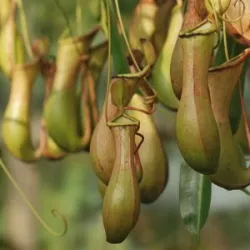Carnivorous plants

Carnivorous plants are fascinating and unique, adapted to capture and digest animals, mainly insects, to complement their nutrition. They generally grow on their own poor in nutrients, especially nitrogen, and therefore develop this ability to obtain the elements that we cannot access through the roots. There are several species, and each has a different method to capture its prey.
A jug plant, for example, has a structure in the shape of a jug or flake, which contains a non-fused digestive fluid. Sua borda is escorregadia, or what looks like the insects fall into liquid form, where they are only digested. Já a dioneia (ou "killer hitter"), possui folhas that are quickly dated to the detection of the movement of a prey, imprisoning it inside its armadilhas. The saracenia uses sheets with large tubes that attract the insects with their nectar twelve, but they run them inside the plant, where they are digested.
These plants not only capture and digest prey, but also have specialized enzymes that break down the tissues of the prey to extract essential proteins, vitamins and minerals. This adaptation is a notable example of how nature can evolve and create complex solutions to environmental challenges. Carnivorous plants are one of the two most fascinating mysteries of biodiversity.
Did you know??














